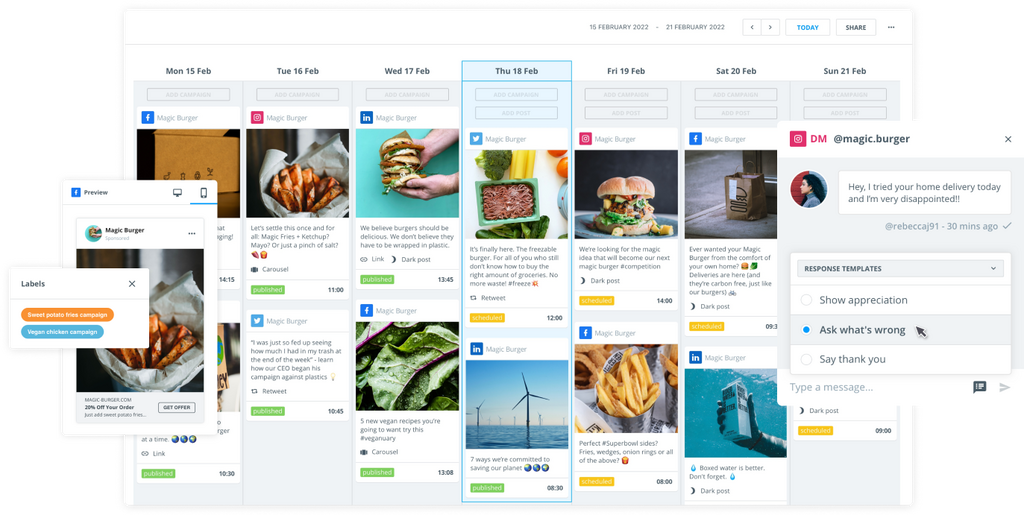20 Social Media Holidays to Celebrate This May
By Yasmin PierreApr 10
Read the practical framework for leveling up your social media team.
Published January 31st 2020
Four years after Mark Zuckerberg announced the arrival of Facebook Messenger bots, the technology has established its value for brands many times over.
However, they remain an underused channel with there “only” being around 400k Facebook Messenger chatbots in active service.
It appears there are plenty of companies who are yet to discover how Facebook Messenger bots can boost their bottom line and customer experience through automation.
At the most fundamental level, chatbots offer a way for organizations to automate many low-level customer service functions.
Instead of waiting on hold to speak to a service agent, customers can chat with a bot to answer basic pre-purchase questions, or to complete the early stages of an RMA returns request.
Chatbots are supported by a range of different platforms, but Facebook Messenger is probably the most important when it comes to dealing with shoppers.
After all, Facebook Messenger use now far exceeds that of the social network itself among consumers.
In fact, according to Business Insider, the top 4 messaging apps now have more active users than the top 4 social networks.
Customers simply click the “Message” button on your Facebook page (or website) and a Messenger session is launched automatically, allowing them to type a question and begin chatting with your bot.
With the right chatbot in place, virtually any customer interaction can be initiated and automated using Messenger.
With a well-staffed customer service department, bots may seem like a pointless extravagance—but they offer all businesses significant benefits, including:
What effect will these benefits have on your bottom line? Prepare to have your mind blown.
Juniper Research estimates chatbots will cut global business costs by $8 billion a year by 2022.
Considering the power of Facebook chatbots, you’ll probably be surprised to hear that they can be built by anyone.
With tools like Chatfuel you can build and deploy a bot in just 7 minutes—and you don’t have to be an experienced developer, either.
In fact, there is no coding required at all.
If you already have a Facebook page in place, the basic bot building process looks like this:
Visit Chatfuel.com and click the Get Started for Free button on the homepage. You will be prompted to log in to your Facebook account and grant Chatfuel permission to access your public profile and email address.
With your Facebook login confirmed, you will be redirected to your Chatfuel account dashboard. Click “Connect” to add your Facebook page. Chatfuel will show a welcome message to confirm the page has been linked successfully.
The next step is to create a welcome message that will be shown to your customers when they launch a Messenger chatbot session. This message is extremely important because it tells users what to do and what to expect.
Now when a customer clicks the Message button (see stage 6) on your Facebook page, this message will be displayed first.
When a chatbot session is launched, your user is shown a ‘welcome message’.
This is where you can greet the customer by name and provide further hints about how to get the most from their chatbot session.
And that’s it—the changes are saved automatically. You can test the welcome message yourself by visiting your Facebook page and clicking the Message button.
Sometimes a user will ask a question that the Facebook Messenger chatbot cannot answer. When this happens, you will need a default reply to tell them what to do next (email support, reword their question, call your helpdesk, etc.).
Again, your changes are saved automatically.
The true power of chatbots comes from their use of Artificial Intelligence (AI) to fully understand what your customers are asking. Chatfuel uses keywords to train the AI system, so you will need to give your chatbot some to work with.
It is worth speaking to your customer service department to find out the most common questions they are asked and use those to set up your AI.
Unfortunately, the Message button mentioned above does not magically appear on your Facebook page—you have to add it yourself. Here’s how:
There is much, much more that can be done with Facebook Messenger chatbots, including creating galleries and other ‘visual’ elements to make the customer experience more pleasant.
Using Chatfuel, you can also carry out Messenger-based marketing activities, like embedding a live chat widget on your website, acquiring users from comments on your Facebook page and sending messages to anyone who has subscribed to your chatbot.
If you want to know more about configuring and improving your first Facebook Messenger chatbot, take a look at the comprehensive Chatfuel tutorials and documentation on their website.
If you’ve followed this quick guide, you now know how to make a Facebook Messenger bot—and you’re well on your way to improving the experience customers have when they try to contact your brand.
That means you’re also on the way to providing more efficient, lower cost support to clients without compromising the quality of service. Cheers!
Offering up analysis and data on everything from the events of the day to the latest consumer trends. Subscribe to keep your finger on the world’s pulse.
Leverage the industry-leading, all-in-one social media management solution.
Existing customer?Log in to access your existing Falcon products and data via the login menu on the top right of the page.New customer?You'll find the former Falcon products under 'Social Media Management' if you go to 'Our Suite' in the navigation.
Brandwatch acquired Paladin in March 2022. It's now called Influence, which is part of Brandwatch's Social Media Management solution.Want to access your Paladin account?Use the login menu at the top right corner.
